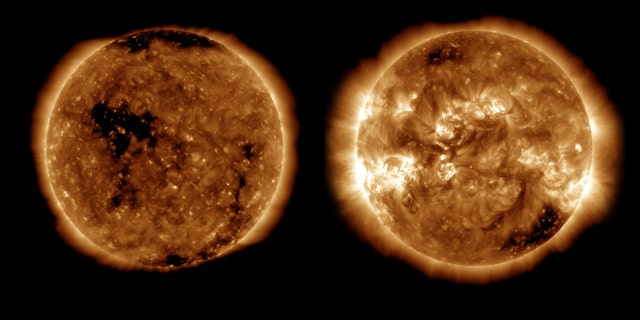NASA said its STEREO-A spacecraft is passing between the sun and Earth on Saturday.
The visit marks the first Earth flyby of the nearly 17-year-old mission.
The twin Solar Terrestrial Relations Observatory spacecraft launched on October 25, 2006, from the Cape Canaveral Air Force Station in Florida. STEREO-A was first, and STEREO-B followed, orbiting around the sun.
The dual spacecraft mission provided the first stereoscopic – or multiple-perspective, allowing researchers to extract three-dimensional information from 2D images – view of our closest star. After both reached 180-degree separation in their orbits, the sun was seen as a complete sphere for the first time in 2011.
RUSSIA LAUNCHES MOON PROBE FOR FIRST TIME IN A HALF-CENTURY

Technicians at Astrotech Space Operations wait to maneuver NASA’s Solar Terrestrial Relations Observatory (STEREO) during a media opportunity August 11, 2006, in Titusville, Florida. ((Photo by Matt Stroshane/Getty Images))
While mission control lost contact with STEREO-B after a planned reset in 2014, STEREO-A continues its journey.
The spacecraft’s lead on Earth has grown to one full revolution as it “laps” the Earth in our orbit around the sun.
The agency said the passing brings a chance for it to collaborate with other NASA missions near Earth and reveal new insights into the sun.
It will once again combine views to achieve stereoscopic vision, synthesizing its views with NASA and the European Space Agency’s Solar and Heliospheric Observatory and NASA’s Solar Dynamics Observatory.
Earth is changing throughout the flyby, and NASA said it is “optimizing its stereo vision for different sized solar features at different times.”

A Boeing Delta 2 rocket lifts off from launch pad 17B at Cape Canaveral Air Force Station carrying NASA’s STEREO spacecraft at Cape Canaveral, Florida, October 26, 2006. ((Photo by Matt Stroshane/Getty Images))
WEBB REVEALS COLORS, FEATURES OF MOST DISTANT STAR EVER DETECTED
Scientists taking advantage of the opportunity to test a new theory that coronal loops aren’t what they appear to be and are identifying active regions with the aim of revealing 3D information about their structure that is usually lost in 2D images.
“There is a recent idea that coronal loops might just be optical illusions,” Terry Kucera, STEREO project scientist, explained.
What the spacecraft will feel as it whizzes by Earth could also lead to major discoveries.

Images from NASA’s Solar Dynamics Observatory show the sun at solar minimum in October 2019 (left) and the last solar maximum in April 2014 (right). Dark coronal holes cover the sun during solar minimum, while bright active regions — indicating more solar activity — cover it during solar maximum. (Credits: NASA’s Solar Dynamics Observatory/Joy Ng)
During and after STEREO-A’s Earth flyby, any Earth-directed coronal mass ejection – plumes of solar material – will pass over STEREO-A and other near-Earth spacecraft, providing scientists with multipoint measurements from inside the ejection.
CLICK HERE TO GET THE FOX NEWS APP
Notably, back in 2006, STEREO-A was close to Earth during a low point in the sun’s cycle of high and low activity. This time around, NASA says, will be different.
“In this phase of the solar cycle, STEREO-A is going to experience a fundamentally different sun,” Lika Guhathakurta, STEREO program scientist, said. “There is so much knowledge to be gained from that.”
